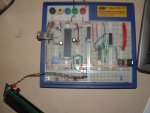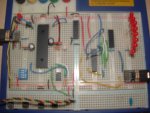hello again,
am still working on my led chaser am using an 20x2 to control 9 led that part is going well. making varies subroutine for different sequences
what am struggling with is how to activate the varies subroutine
i have a 40x2 which is the master picaxe and i thought using the I2C
but am struggling to see how to implement this idea infact hit a mental wall
would someone kindly give a code sample PLEASE O PLEASE of how master and slave should look too get an led plinking on the 20x2 slave or guide me in the right direction.
i thought it would be of case master writes a variable in the slave somewhere the slave looks up the variable then would go to a subroutine
and that as far as can visualise
not even sure if I2C is the right way to go?,
any advice would be helpful cheers rob
PS i do read the manuals still do, just takes months for it to sink in.
am still working on my led chaser am using an 20x2 to control 9 led that part is going well. making varies subroutine for different sequences
what am struggling with is how to activate the varies subroutine
i have a 40x2 which is the master picaxe and i thought using the I2C
but am struggling to see how to implement this idea infact hit a mental wall
would someone kindly give a code sample PLEASE O PLEASE of how master and slave should look too get an led plinking on the 20x2 slave or guide me in the right direction.
i thought it would be of case master writes a variable in the slave somewhere the slave looks up the variable then would go to a subroutine
and that as far as can visualise
not even sure if I2C is the right way to go?,
any advice would be helpful cheers rob
PS i do read the manuals still do, just takes months for it to sink in.


